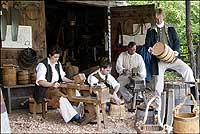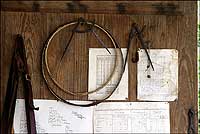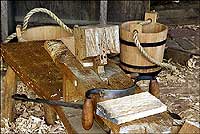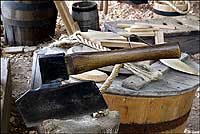Page content
Making Circles
text
by Ed Crews
photos by Dave Doody

Near the windmill in the Historic Area, Colonial Williamsburg coopers coax straight wooden staves into round casks. From left, Ramona Vogel, Marshall Scheetz, Jonathan Hallman, and Master James Pettengell, holding a gunpowder keg.
Casks were essential, commonplace items of colonial life and commerce. Almost everybody used them. England's trade depended on them. Shippers sent them throughout the empire, packed with such luxuries and necessities as flour, wine, shoes, books, and leeches used in medicine. To accommodate so many goods, these wooden containers — now often and inaccurately called barrels — came in sizes. Some were small, like the handy gunpowder keg. Others were huge, like the hogsheads built to hold 1,200 pounds of tobacco. The unglamorous yet versatile cask of the 1700s was as necessary, varied, and unremarkable as today's cardboard box.
Colonial Williamsburg guests can appreciate the cask's eighteenth-century ubiquity by glancing around the Historic Area. Casks fill shops, stores, and kitchens. Williamsburg's coopers made most. Working from a shed near the windmill, journeyman Jonathan Hallman and apprentices Marshall Scheetz and Ramona Vogel practice the craft under shop master James Pettengell.
Pettengell has spent a lifetime in coopering, a trade that caught his fancy in England when he was a boy of nine or ten. "I went with my father to a brewery, and everything I saw intrigued me," he said. "The cooper's shop was a loud, smoky place. Guys were tearing around, hammering, twisting, and pulling. The place had a strong smell of oak. The scene was surreal, strange, and fascinating. I was captivated." At fifteen he became a cooper's apprentice at the Whitbread and Company brewery in London, founded in 1742, where he learned the craft, and became a journeyman. He joined Colonial Williamsburg in 1971, bringing training and experience that gave him a deep understanding of the cooper's trade in the eighteenth century.
Casks have ancient roots and many virtues. They are tough, versatile, and easily moved because they roll. They were perfect for Great Britain's global trade network in the 1700s. Demand was strong. Pettengell says that by the 1750s British coopers at home and in the colonies made hundreds of thousands of casks annually. Virginia coopers made about 300,000 a year.
The trade's size ensured that the cooper's guild was powerful. It also was old, receiving a royal charter in the 1500s. Coopers often clustered in seaports, where the market was healthy. Large, thriving shops operated in the British cities of Glasgow, Liverpool, London, Portsmouth, and Plymouth. In Virginia, many coopers settled in Norfolk and Yorktown. Large tobacco plantations also often had slaves skilled in the trade. Coopers served aboard military and merchant vessels, too. They inspected cargo, repaired damaged casks, and built new ones.
Shippers rarely employed coopers. Instead, merchants bought casks from producers. In major seaports, these cooperages were large. The shops frequently had production contracts with major trading firms, ensuring a steady supply for customers and a steady business for manufacturers. Often, shops specialized in specific casks. This enhanced efficiency and profitability. The level of specialization was impressive.
Modern Americans think of all these containers as barrels. The general eighteenth-century term was "cask" or "casque." Barrels were a type of cask. A barrel of gunpowder had a 100-pound capacity. A barrel of beer held 36 gallons. Large wine casks were known as butts and pipes. A butt held 130 gallons. Wine also came in rundlets, which held 18 gallons; tierces, 42 gallons; and puncheons, 84 gallons.
Specialization also allowed individual coopers to increase revenues because they were paid by the cask. If a cooper became proficient in one type, his output was high and fast. For the industrious, cask making provided a comfortable living.
The craft had three broad divisions. "Tight work" produced containers for liquids. "Dry tight work" made casks for fine, powdery material, like flour. "Slack work" created containers for dry goods. Although not technically part of the cooper's trade, "white work" involved making buckets and tubs. Today's Williamsburg coopers make those items as well as casks.
Cask work began with the cooper selecting flat planks, called blanks, to make staves. Supplied by contractors, these arrived in uniform length and thickness. Tight work mainly required white oak. Slack work used red oak, chestnut, and yellow pine.
Assembly involved shaping the selected blanks, bending them, fitting them together, banding them with a hoop, and installing the round endpieces, or heads. The cooper used about twenty-five tools, including a broad ax for tapering, a backing knife to shape the cask's external curve, and a hollowing knife to shape the inside curve. To bend the staves, and later to harden them, a cooper applied heat from a fire.
Simple in theory, cask making was difficult in practice, demanding intellectually and physically. "Coopering is hard to learn," Pettengell said. "This trade isn't — and wasn't — for everyone. Apprentices here are not typically finished. Since 1971, only three people have completed their training. This job offers no instant gratification. Not everybody can see in his or her mind how a cask comes together. The abstract part of this is demanding. Often, people get frustrated."
That frustration stems from the shape of a cask — a bulging round middle with sides that taper inward toward both ends. "The hardest thing to learn is developing the skill for seeing the angles, curvature, and tapers by eye," apprentice Vogel said. "In the modern world, this type of skill is generally not practiced and is difficult for the layperson to understand because it's not tangible."
Pettengell expresses the thought in a Zenlike statement he often uses to describe his trade: "We make circles."
This circular world can be demanding. Consider mastery of one tool — the croze.
"To the extent that any one aspect of the work is any harder to learn than any other, I suppose the skill that I found most difficult to master was the use of the croze, which is the tool used to cut the groove into the end of the container that the head fits into," journeyman Hallman said. A cooper must cut that groove straight, at a uniform depth and so that an endpiece sits flat across the cask's end. All must be done cutting along a slope inside a circular container.
The craft also has strong physical and sensory demands. Coopers had to cut, shape, bend, and hammer. Because profit and speed went hand in hand, large eighteenth-century cooperages were scenes of frenzied activity. Experienced coopers never measured anything. They gauged by eye, by feel, and by sound. The cooper perceived progress through touch. He also used sound — thumping a sealed cask and listening for the tone — to check stave snugness.
Like other eighteenth-century crafts, cooperage changed with the Industrial Revolution. Cask-making machinery supplanted handwork in the late 1800s. During the twentieth century, metal barrels, cardboard boxes, fiberboard drums, and large metal shipping containers largely replaced wooden casks. Although the cooper's is a demanding and an all-but-vanished craft, everybody at Colonial Williamsburg's shop is drawn to it. Pettengell likes the trade's physical aspects. Vogel enjoys woodworking, and Hallman delights in the satisfaction that finishing each project brings. Scheetz feels the tug of tradition.
"I see an opportunity to learn the trade uncorrupted by time from a master cooper who learned it from his master and so on back in time," he said. "This is history in its purest form."
Pettengell said, "The plan for the cooper's shop is to preserve the skills necessary to use the traditional tools, and by so doing to preserve the technology of the cooper's trade overall. This is ongoing. I have made the following statement many times; however, I do believe it will encapsulate what we are all about: Without production, there is no preservation."
Quicktime video excerpts from Colonial Williamsburg's "The Cooper's Craft: The Art of Colonial Barrel Making" video.
A good barrel begins with a fine tree.
The cooper shapes the timbers into barrel staves.
Coopering is a craft as old as civilization.
A cooper's tools are handed down through generations.
The master cooper guarantees the casks made in his shop.
Richmond writer Ed Crews is the author of a long-running journal series on colonial trades. His story on cabinetry appeared in the summer 2003 magazine.
For further study:



